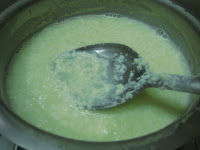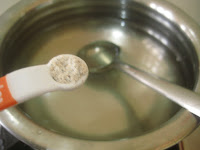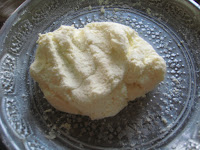Sponge Rasgullas
Today's post is everybody's favourite sweet dish - Rasgulla. Rasgulla is a popular Bengali sweet. Its basically from Puri
( Orissa ) but borrowed and modified by Bengal. If you google for the information about rasgulla, you will know some interesting facts. This is a 700 year old dish which was prepared for Goddess Lakshmi in Puri. Hence we can come to the conclusion that Rasgulla is a very traditional dish. Now lets not go into the details of the origination and lets see how it is prepared.
There are many versions of preparing Rasgulla. Many fail to get the perfect rasgullas. I was one of them. The first time I prepared Rasgulla ( that was a few years back ), I failed miserably and the rasgulla was hard. My man did not like it. I was scared to attempt for the second time. But I dared to do it. The result was ok. Time and again, I tried to perfect this dish and eventually I was able to do it.
As the saying goes, practice makes a man perfect, the same is the case with this dish. The more you prepare, the more you learn and can perfect it. You can prepare awesome rasgullas just like the store bought ones.
Rasgulla is made from chenna. Chenna is made from curdling milk. Chenna is soft paneer. The rasgulla gets its softness from the softness of the chenna. So, the way you prepare chenna is very important to prepare the rasgulla. So lets see how it is made.
Preparation
Take milk in a vessel and let it come to a boil.
Mix for a few minutes until the milk is curdled.
As soon as you see the whey is separated and is transparent, add the ice cubes. Ice cubes are added to stop the cooking process so that the chenna doesn't become hard and remains soft.
Immediately strain the chenna in a muslin cloth or a thin cotton cloth and pull the edges of the cloth together.
Squeeze gently and hang it to the tap in your kitchen sink.
Leave for about 1 hour. Do not throw away the whey. You can use this for preparing the chapathi dough or for preparing any curry. After an hour, lets prepare the sugar syrup. Add sugar and water and keep it on high flame.
Keep mixing until the sugar is dissolved.
Cook until you see small droplets forming at the bottom of the pan. Switch off the flame and add lemon juice. Lemon juice is added to prevent crystalisation of sugar.
Add elaichi powder and mix well.
Keep this aside ( on the stove with no flame ) such that it stays warm.
Now take the hung chenna in a plate and gently knead into a dough.
Now, there are some very important points to be noted here. The dough should not contain any moisture in it, else the rasgullas will break while cooking. At the same time, it should not be too dry either. So the chenna should be just perfect. There is a very thin line to differentiate if chenna has moisture or not. In fact, its very difficult to explain. It just comes by experience, by touching the chenna. When you touch it should be soft.
And once you start kneading, just after a couple of minutes, you fingers will start greasing. That means, the oil or fat in the chenna start releasing and sticks to your fingers. At this point, stop kneading and form small balls.
Cover it a lid or a damp cloth so that the balls do not dry out. Now lets prepare the syrup for cooking these balls. Take sugar and water in a big vessel. The vessel should be big enough because the balls will double in size while cooking, so it should have enough space. Else there is a chance that the balls might break up or not cook properly. I have taken an idli cooker removing the inner plates. You can also use a pressure cooker for cooking the same. The water content in the vessel should be more than 1/4th that of the vessel's capacity.
Put this vessel on a high flame and mix until the sugar dissolves completely. Let it come to a vigorous boil.
Allow to cook for 4-6 minutes. After 6 minutes, remove the lid and check if the ball has doubled up or not. If it is doubled up, add in the remaining balls one after another amd cover with lid. Cook for 6-8 minutes. If you are using an idli cooker, then cook until you get the whistle sound. Remove the lid and check if the balls are completely cooked or not. To check if the balls are completely cooked, take a rasgulla ball and put in a glass of water. If it sinks to the bottom of the glass, then the balls are perfectly cooked. If it floats, then put the ball back in the vessel and cook for some more time. Once they are cooked, remove them one after another and put in the sugar syrup that we prepared earlier.
If you have another batch of balls to cook, then add a few tablespoons of water and bring the sugar syrup to a vigorous boil again. And repeat the process again. Allow them to cool and serve after an hour or serve after refrigeration. Garnish with saffron strands and serve. These rasgullas are so soft and juicy that they just melt in your mouth. I could make 27 small rasgullas from the above measurements.
Ingredients
Milk 1.5 litres ( preferably whole cream milk )
Curd 7-10 tbsp.
Ice cubes 2 trays
Saffron strands for garnishing
For Sugar Syrup
Sugar 1.5 cups Or 250g
Water 1.5 cups
Elaichi powder 1/4 tsp
Lemon Juice 1/2 tsp
Sugar Syrup for cooking
Sugar 1 cup Or 150g
Water 6 cups
Method
- Take milk in a vessel and let it come to a boil. When it is about to boil, add curd and mix well.
- The milk will start curdling. When the chenna has completely separated from the whey, add ice cubes to stop the cooking process. This helps in keeping the chenna soft and not becoming hard.
- Immediately, strain the chenna in a muslin cloth or a thin cotton cloth.
- Get the edges of the cloth together and gently squeeze the water. Hang this cloth with the chenna on the tap in your kitchen sink.
- Leave it for about 1 hour.
- Lets prepare the sugar syrup. Take water and sugar and keep it on high flame. Mix until the sugar dissolves. Cook until you see small droplets forming at the bottom of the pan.
- Switch off the flame and add lemon juice and elaichi powder and mix well.
- Keep this aside in a warm place. Make sure that this syrup is warm when you are adding the rasgullas to this syrup.
- Take the hung chenna and knead smoothly and gently with your fingers. The consisitency of the chenna is very important for the preparation of rasgullas.
- There should not be moisture in the chenna neither should it be too dry. Be very careful to make a note of this point.
- Knead the chenna until your fingers start greasing. Stop kneading when your fingers are greasing and form small balls.
- Keep this aside cover with a lid or a damp cloth so that they do not dry away.
- Take water and sugar for cooking in a big vessel or a cooker. Mix until the sugar is completely dissolved and allow it come to a vigorous boil.
- When it is boiling vigorously, drop the balls slowly one after another. Cover with a lid and cook for 6-8 minutes.
- If you are not sure of the dough's consistency, drop just one ball and cover with a lid. Cook for 6-8 minutes.
- After 8 minutes, remove the lid and check if the ball has doubled up. If it doubled up, then your dough's consistency is right.
- So, drop the other balls one after another in the vigorously boiling syrup and cover with lid.
- Cook for 6-8 minutes or until you hear the whistle sound.
- Remove the lid and check if the balls are completely cooker.
- To test if the balls are completely cooker or not, take a rasgulla and put it in a glass of water. If it sinks to the bottom, then the rasgulla is cooked. If it floats, then drop it back in the sugar syrup and cook for some more time.
- Once the balls are cooked, remove the rasgullas one by one and drop them in the sugar syrup prepared earlier.
- If you have to cook another batch of balls, then add little water to the boiling sugar syrup and allow ti come to a vigorous boil. Now drop the remaining balls and repeat the process.
- Allow them to cool and then refrigerate. Serve chilled or at room temperature after garnishing with saffron strands.
Notes
- The chenna should be soft. If the chenna hardens, then you will get hard rasgullas.
- The consistency of the chenna dough is very important. It should not have too much moisture. At the same time it should not be too dry.
- Too much kneading of the dough is not good. Knead only until the chenna starts releasing the fat ( grease ).
- The sugar syrup in which we cook the rasgullas should be boiling vigorously.
- It is always better to drop one ball the first time to check if the consistency of the chenna dough is fine or not. There are always chances that the balls break and mix in the sugar syrup. So, this way, atleast we will not waste up the remaining balls.
- When you are cooking the second batch of rasgullas, add little water before you drop the balls. This is done to ensure that the sugar syrup doesn't thicken. Again, allow it to boil vigorously. Then drop the balls and cook them as before.
- These spongy rasgullas will not retain the round shape as we do not add any maida or sooji.
- If you want the rasgullas to retain their round shape, then add 2 tbsps. of sooji or maida into the chenna dough and knead well. But you will not spongy and juicy rasgullas.
- I will do another post with maida or sooji rasgullas and will show you the difference. Keep watching this space.





























No comments:
Post a Comment